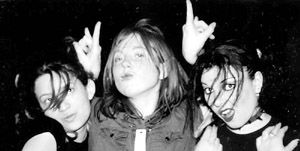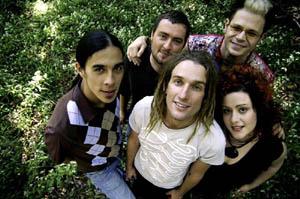Headkase had reached a point where we were attracting record crowd numbers at Her Majesty's Bar (The Basement), and being invited to open for some of the major touring acts in bigger venues. Doing something different and refreshing was starting to pay off.
 |
| Front page of "QLD Times" Entertainment liftout |
An "Anti-Headkase Neo-Nazi group" sounds a bit dramatic. That's what we thought when we learned that it wasn't just one or two grumpy members of our audience who weren't too impressed with what they saw and heard one time.
It began with abusive posts on the Headkase message forum about how we're sloppy and lame, we're not heavy enough, we're all "gay" because we try (and fail) to splice metal with other genres. We can take criticism. Sure, it's not constructive criticism, but bands get this sort of thing all the time. Eventually these sorts of posts started appearing more frequently, in several public message forums like the Time Off Message Board, and the guest books of record labels and popular bands at the time. And then the hate emails started filling up our inbox.
Pretty soon, they decided to take it to the streets. Posters were being plastered around the streets, music stores and venues of Brisbane trying to convince the town to boycott Headkase and it's homosexual members. None of us are gay, but our music and image somehow made them believe we were. Websites were built as well, doctored photos and even drawings were being uploaded, and every online music forum and guestbook was filled with anti-Headkase propaganda, and spam from people posing as members of the band, unprofessionally bragging about how superior we are to all the other bands in Brisbane. Rumours were being spread, our name was being brutally dragged through the mud, and people were actually believing what they were reading. Bridges were being burned, as they insulted and badmouthed every band we'd become friends with. And, frustratingly, people who'd never heard of Headkase were getting this false first impression, and believing every word of it.
Before the advent of social networking websites like MySpace, Facebook and Twitter, and before the law and media started taking online bullying and defamation seriously, I gathered up printouts of all the abusive posts and emails (some threatening violence against us, with comments such as, "You'd better watch your backs at your next gig"), as well as posters I'd taken down, and brought them into the Police Station on Adelaide Street. It was shrugged off and taken lightly. "There's nothing we can do about it", one officer said. "It's a civil matter. Just get the personal details of the people involved, and take them to court".
Getting the names and addresses of anonymous cyber bullies was not going to be easy. Nobody was able to trace where the emails and guestbook posts were coming from. None of the music forum owners were willing to cooperate, saying that everyone has a right to their opinion. They wouldn't even remove the offending posts for us. Meanwhile, the hateful replies underneath the posts were growing rapidly. Even people who admitted that they were once fans had been brainwashed and turned against us.
One day, a friend/fan of the band came up to me at The Basement, and gave me a quiet tip-off. "Don't tell anyone I told you this, but I saw who put up one of those posters. I kinda know him, but he's a bit of a dick". I promised I wouldn't rat him out for telling me. "I don't know his last name, but he goes by the nicknames of 'John the Fascist', 'Facepaint John' and 'Gay John', and he is a strong believer in Neo-Nazism". Immediately, I asked, "Why do they call him 'Gay John' if he hates gay people, and 'Facepaint John' if he hates the fact that some of us in the band wear facepaint and masks on stage?". Turns out 'Gay John' was just a silly name mates called him, poking fun of his hatred of gay people. And 'Facepaint John' was due to the fact that he would wear white facepaint, similar to that of the racist, anti-christian members of the Norwegian black metal scene (pictured), responsible for many of the infamous Church burnings in the early 1990s.
 |
| Headkase t-shirts |
Gradually, I started piecing together all kinds of information about John the Fascist and some of his associates. Any information I received was given in secrecy, and in very small doses. There was a hint of fear from those who divulged any information. Some people simply said that while they respect what the band does, they're also friends with John and didn't want to betray their friend. I started hearing stories of people who were beaten for wearing Headkase t-shirts. And many of these stories were linked to other hate crimes against Asian people and gay people, specifically a lot of the bashings outside the Wickham Hotel in the Valley. But nobody was willing to give any more information.
At one show, there was a group of about six goths in white facepaint who were chanting, "Nigger lovers!" at us while we played. There really didn't seem to be any basis behind these racist and homophobic statements being used against us, all because we dared to play music that was a bit different to what other metal bands were playing. The silliest part about the whole thing was the fact that these people were devoting so much of their time and money to this cause. The printing costs for posters and flyers, the time spent on hanging them up and handing them out, the time spent building websites and writing on countless message forums and guestbooks, and the entry fees spent on getting into our shows. Why would you pay money to see a band you hate so much?
Thankfully, the threats of violence towards us never became any more than threats. However, I was appalled to think that acts of violence were being carried out towards our fans for wearing our t-shirts. Especially since the Police still refused to act without full names and address details. I had all the evidence, clues and leads for an investigation that they simply didn't want to be a part of. Venues like The Basement who took the matter seriously were putting on extra security at our shows, for the protection of the band and the fans. Both the front entry for the public, and the back entry for bands were being checked to make sure nobody was bringing in weapons. And roaming security guards were making sure nobody was organising any attacks, especially during our performance. Even enthusiastic fans in the mosh pit who lunged forward towards the stage were pushed back by security.
By 2007, the madness had died down. Any internet nonsense that was still going on was going unnoticed thanks to MySpace and the measures they had to keep riff raff like that away from band profiles. The band continued playing, and we'd gone through several waves of fans in that time. Many of the original regulars who packed out The Basement had long stopped attending shows. They'd hung up their leather pants, boots and spiky collars, gained full time employment, gotten married and had kids. But with every new wave of fans, we were still able to pull large crowd numbers. The "Overcranked" festival at the RNA Showgrounds was a highlight, and certainly reassured us that people were still willing to come out of the woodwork in large numbers to see us. MySpace helped to raise our profile nationally and even internationally as well, which worked in our favour when it came to touring and releasing an album.
In the next post, I'll talk about a couple of other bands I was in during this time - Silent Partners and Marlinchen.
To be continued...
Part 4 - http://geekazoidopinion.blogspot.com/2011_08_01_archive.html
To be continued...
Part 4 - http://geekazoidopinion.blogspot.com/2011_08_01_archive.html

























